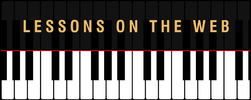|
The Circle of Fifths is one of the best tools any piano player can learn to use to make their playing and understanding of music much better. It tells us key signatures, helps us understand the makeup of chords and how to read them faster, and even know the specific primary chords of each key. Every key signature – both major and minor keys – are shown on the Circle of Fifths. (I show you this in the video at the end). A key signature in any piano piece or etude tells us what exact notes we are to play in that piece.
When we learn the key signatures for all of the different major and minor keys by memory, we will be able to automatically play the correct notes simply by observing what they key signature is at the beginning of the piece (or sometimes each line of the music, as they key signature can sometimes change during a piece). Scales are made up of 8 notes (the 1st and 8th notes are the same, just an octave apart) that share the same key signature.
An easy way to learn your minor key signatures is to know that every minor scale has a shared key signature with its relative major key. In other words, G Major shares the same key signature with E Minor. Since G Major has F# in it, then E Minor will as well…and you just play E Minor the same way you would play G Major except that you start on E instead of G. As you will see when you watch the video, the minor keys are listed on the inside of the circle next to its respective relative Major key. Learning the Circle of Fifths is especially helpful to those who play by ear or with a group or band. You will be able to switch back and forth between different keys and Major and Minor modes easily without having to look up the key signatures. Knowing your key signatures from the Circle of Fifths will help you recognize and play the primary chords and any other chords you are learning in your pieces.
Chords are played using the same notes in the key signature that we play in a scale. The difference is that the notes are being played together in a group at the same time instead of one at a time like we do in a scale. Simply stated – any chords you play have to include the notes in the key for the piece. If the piece is in G Major, then all of the chords will have to have an F# in them (if indicated) to match the given key signature. It’s much easier to read and play chords when you can identify what the sharps or flats are from the beginning and the Circle of Fifths helps you to do just that! The Major Keys are listed so that you can pick out the primary chords for any key simply by going one key to the left and then go one key to the right of the key you are playing in.
Using the Circle of Fifths to learn and easily recognize your key signatures makes playing the piano much easier. You will be able to identify the primary chords of any key simply by knowing what is to the left and the right of the key you are looking at and you will be able to build chords with the correct notes without having to look anything up or think about which notes you are to play. Use the video to help you visualize these tips in your music and on the keyboard. I also show you how to read the Circle of Fifths chart in case you have any questions. If you like my tips and lessons, you will love the courses over on my website. Whether you are a beginner looking to get a solid foundation to build on or you are looking to take you existing skills to that next level, the online music courses on my website https://www.pianolessonsontheweb.com will help you do just that.
John A Brown
4/3/2023 12:37:23 am
Interested in getting adept at playing chords using circle of 5ths etc
Reply
Leave a Reply. |
AuthorMost blogs written by Archives
June 2020
Categories
All
|

 RSS Feed
RSS Feed